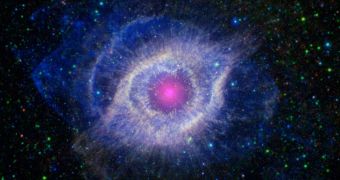According to evidence presented in two recent papers in the journal Astronomy & Astrophysics, it is possible that, when dying, stars not all that different from our Sun contribute to the formation of water in the universe.
The two papers document the discovery of a molecule that scientists say is crucial for the creation of water in the burning remains of Sun-like stars that have reached the end of their life cycle.
As detailed by researchers with the European Space Agency, the molecule in question is a combination of one oxygen and one hydrogen atom, and it is positively charged. Thus, it is written down as OH+.
What's interesting is that, by the looks of it, this molecule not only likes to hang out around dying low- to middleweight stars after having formed someplace else, but depends on them to come into being, Phys Org explains.
If this is indeed the case, this would mean that the water present in the universe can also originate from dying Sun-like stars, the European Space Agency scientists write in the journal Astronomy & Astrophysics.
“Herschel [the Herschel Space Observatory] has traced water across the Universe, from star-forming clouds to the asteroid belt in our own Solar System,” researcher Göran Pilbratt explains during a recent interview.
“Now we have even found that stars like our Sun could contribute to the formation of water in the Universe, even as they are in their death throes,” the scientist goes on to argue.
Of the two papers, one details the discovery of OH+ in three planetary nebulae, i.e. shells of dust and gas casted off into space by dying low- to middleweight stars, whose stars had a temperature exceeding 100,000 degrees Celsius.
The other one documents the discovery of this molecule in the Helix Nebula, which is a planetary nebula that sits at a distance of just 700 light years from our Solar System.
“We think that a critical clue is in the presence of the dense clumps of gas and dust, which are illuminated by UV and X-ray radiation emitted by the hot central star,” Dr. Isabel Aleman offers as an explanation for the presence of OH+ in this environment.
“This high-energy radiation interacts with the clumps to trigger chemical reactions that leads to the formation of the molecules,” the University of Leiden, the Netherlands, researcher further details.
Unlike massive stars, which birth supernova explosions when they die out, low- to middleweight stars settle for merely shedding their outer layers. Studies have shown that, whereas supernovas birth heavy elements, the planetary nebulae created by Sun-like stars create elements like carbon, nitrogen, and oxygen.

 14 DAY TRIAL //
14 DAY TRIAL //